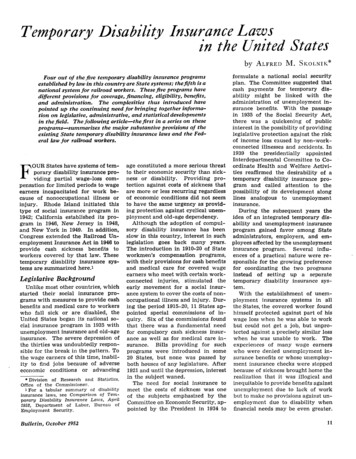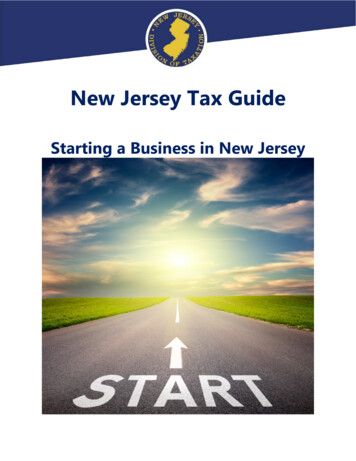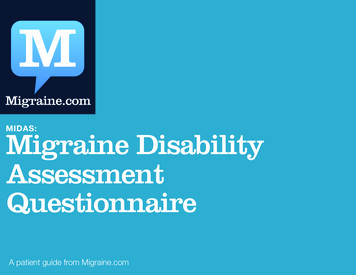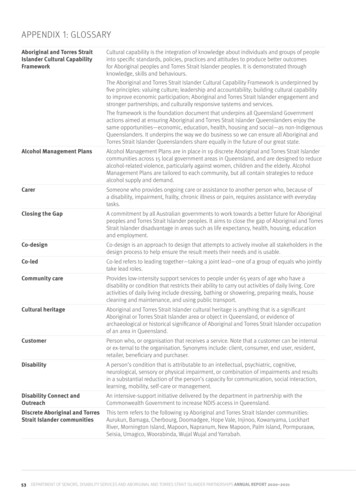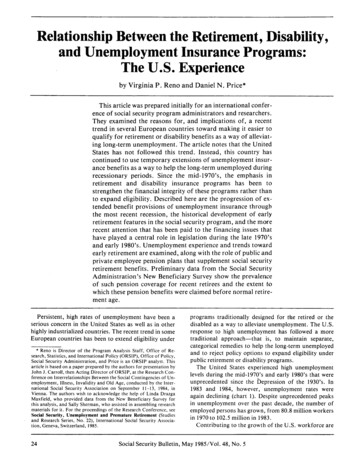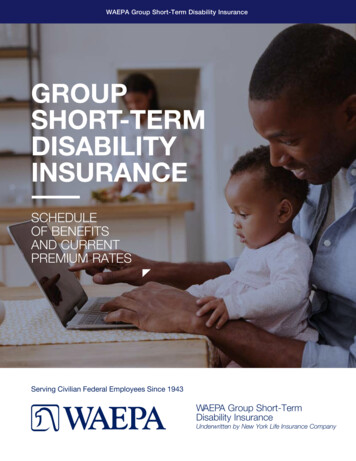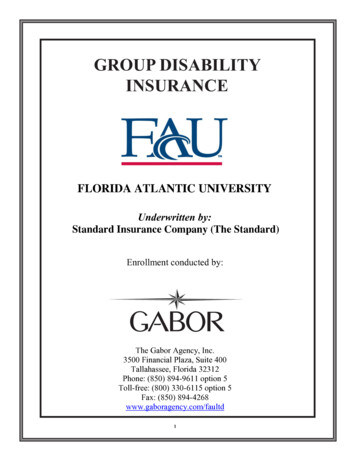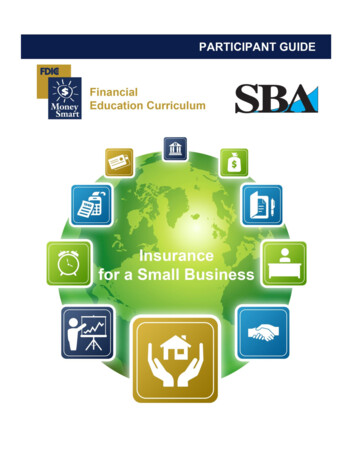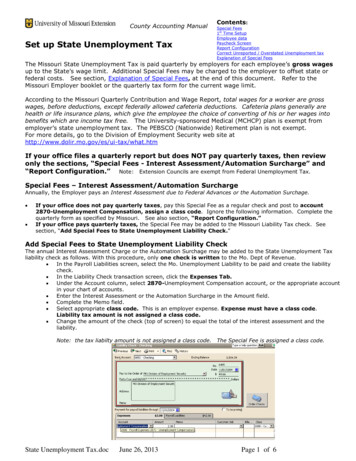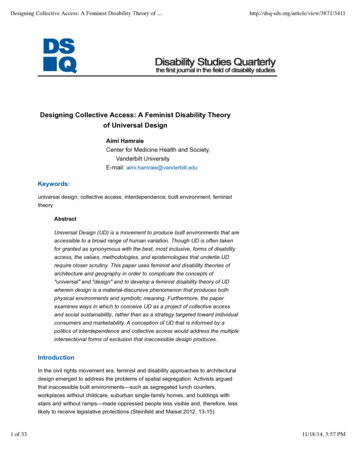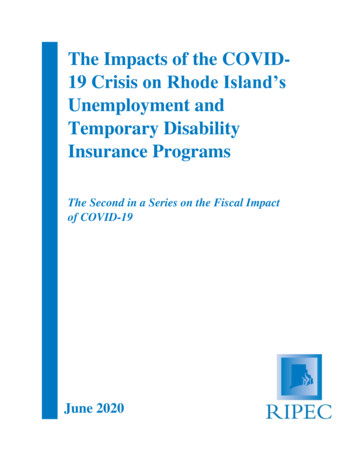
Transcription
The Impacts of the COVID19 Crisis on Rhode Island’sUnemployment andTemporary DisabilityInsurance ProgramsThe Second in a Series on the Fiscal Impactof COVID-19June 2020
Table of ContentsSectionPageI. Introduction3II. Unemployment Insurance6III. Temporary Disability/Caregiver Insurance20IV. Conclusion26Page 2 of 27
I. IntroductionThe COVID-19 pandemic has presented an unparalleled public health and economic crisis. Firstreported to World Health Organization officials out of Wuhan, China in December 2019, COVID19 spread exponentially across much of the globe and throughout the United States betweenJanuary and May 2020. In the U.S., there were 1.7 million confirmed cases and 102,640 fatalitiesby June 1. At the same time, the number of worldwide confirmed cases and fatalities were 6.1million and 371,166, respectively.1 The rapid spread of COVID-19 led governors nationwide totake unprecedented measures that included stay-at-home orders, school closures, and the closureof nonessential businesses. Together, business closures, social distancing protocols, and the globalconsequences of the pandemic—such as a sharp decline in oil prices—have led to unprecedentedunemployment throughout the United States, with a reported 36.7 million unemployment claimsbetween March 19 and May 9 and a 14.6 percent unemployment rate in April.2Regarding both the public health and economic aspects of the COVID-19 crisis, Rhode Island hasbeen one of the hardest hit states in the country. As of June 1, Rhode Island’s 14,991 confirmedcases and 720 fatalities respectively ranked third and fifth highest nationally in per capita terms.3In response to the public health emergency, Governor Gina Raimondo declared a state ofemergency on March 9, and in the weeks thereafter she issued a series of executive orders thatmandated: quarantine for out-of-state travelers, residents to stay at home, and the closure ofnonessential and public-facing businesses.4 On May 9, the governor’s stay-at-home order expiredand the first of three planned phases of reopening began.5 In the meantime, Rhode Island’seconomy has severely contracted. The state experienced an unprecedented uptick in initial andWorld Health Organization, Coronavirus Disease Situation Report – 133, June 1, 2020.U.S. DOL, Unemployment Insurance Weekly Claims Data; U.S. Bureau of Labor Statistics, “The UnemploymentSituation – April 2020.” The measurement of unemployment in the United States is both complicated and confusing.Early each month, the Bureau of Labor Statistics of the U.S. Department of Labor announces the total number ofemployed and unemployed people in the United States. This information, particularly the unemployment rate—thepercentage of the labor force that is unemployed—typically receives widespread media attention. This report is notderived from actual unemployment claims, but instead is the result of a monthly survey of about 60,000 householdscalled the Current Population Survey (CPS). Because the CPS sample size, while large, is insufficient to create reliablemonthly estimates for states or smaller geographical areas, a different method called the Local Area UnemploymentStatistics (LAUS) program is used to produce monthly and annual employment and unemployment data for states,counties, and metropolitan areas. The LAUS program derives its data by utilizing statistical models incorporating CPShistorical data, state UI system information, and data from the Current Employment Statistics (CES) Program, whichsurveys about 145,000 businesses and government agencies each month. U.S. Bureau of Labor Statistics, “Labor ForceStatistics from the Current Population Survey, How the Government Measures Unemployment.” A recent addition tothese complications, U.S. DOL’s state report for April had data collection issues: the survey response rate was lowerthan usual because the Census Bureau did not conduct in-person interviews and two call centers were closed becauseof the pandemic. Tami Luhby, “43 states have record unemployment. See where your state ranks,” CNN Business,May 22, 2020.3R.I. Department of Health, COVID-19 Disease Data, accessed June 1, 2020; New York Times, “Coronavirus in theU.S.: Latest Map and Case Count,” accessed June 1, 2020. Rhode Island’s relatively high number of confirmed casesis in some part due to the availability of testing in the state, which is among the highest in the nation. Michael Powel,“Rhode Island Pushes Aggressive Testing, a Move that Could Ease Reopening,” April 29, 2020.4R.I. Office of the Governor, Executive Orders.5Reopening RI.12Page 3 of 27
continuing unemployment claims between March and May, with a peak of 108,341 initial andcontinuing claims for the week ending April 25, 2020.6 Similarly, Rhode Island’s unemploymentrate experienced its largest month-over-month increase on record between March and April,increasing from 4.7 percent to 17.0 percent.7 Unemployment participation in the United States alsohas hit unprecedented levels, but the Ocean State’s April unemployment rate exceeds that of theU.S., and the state ranked fifth highest nationally in terms of unemployment claims as of April25.8In April, RIPEC issued the first in a series of reports regarding how the burgeoning economicemergency caused by the COVID-19 pandemic has and will impact the State of Rhode Island, andthe critical choices before its policymakers. That report, “The COVID-19 Economic Crisis:Federal Assistance and Rhode Island’s Budget,” analyzes the funding provided to Rhode Islandby the federal government as well as the potential impact of the COVID-19 crisis on the RhodeIsland budget. It also emphasizes the need for additional federal assistance to avoid severebudgetary fallout and offers a set of guiding principles for state policymakers to consider inresponding to current fiscal challenges.9This report, “The Impacts of the COVID-19 Crisis on Rhode Island’s Unemployment andTemporary Disability Insurance Programs,” is the second of RIPEC’s series, and examines thefiscal impact of the COVID-19 crisis on two important income support programs for employees:Unemployment Insurance (UI) and Temporary Disability Insurance (TDI)/Temporary CaregiverInsurance (TCI).10 UI is funded at federal and state levels through employer taxes and TDI/TCI isfunded by state withholding taxes on employees. While both programs are operated as separatefunds apart from the state’s general fund budget, the fiscal health of these programs can have majorconsequences for Rhode Islanders.In addition to this introduction, there are three sections in this report. Section II gives a brief historyof UI, describes UI’s federal and state funding mechanisms, and examines the relative solvency ofRhode Island’s UI trust fund balance. Section II additionally delves into how COVID-19 hasaltered benefits, eligibility, and claims trends, as well as the probable impact of COVID-19 claimson the trust fund and the likely consequence of trust fund insolvency for Rhode Island employers.Similarly, Section III provides historic background on the state’s TDI/TCI program, details itsbenefit structure, and describes how the program is funded, before explaining how COVID-19 hasR.I. DLT, “Weekly Update of Claims Activity, Week Ending: April 25, 2020.”R.I. DLT Media Advisory, “Rhode Island-Based Jobs Fell 88,800 from March; April Unemployment Rate Rose to17.0 Percent,” May 21, 2020. The second largest month-over-month unemployment rate increase in Rhode Islandhistory was from February to March 2020 (3.4 percent to 4.6 percent). R.I. DLT Media Advisory, “Rhode IslandBased Jobs Fell 5,600 from February; March Unemployment Rate Rose to 4.6 percent,” April 16, 2020.8U.S. DOL, News Release, “Unemployment Insurance Weekly Claims: May 9, 2020,” May 14, 2020.9RIPEC, “The COVID-19 Economic Crisis: Federal Assistance and Rhode Island’s Budget,” April 2020.10Over the past several years, RIPEC has published reports on both UI and TDI. See: RIPEC, “Summary ofUnemployment Insurance Analysis of the Rhode Island Unemployment Insurance Trust Fund,” January 2011; RIPEC,“Rhode Island Temporary Disability Insurance (TDI) and Temporary Caregiver Insurance (TCI),” June 2015; RIPECPolicy Brief, “How Rhode Island Unemployment Insurance Benefits Compares,” February 2019.67Page 4 of 27
impacted both eligibility requirements and claims trends. Section III subsequently models howelevated TDI/TCI claims during the COVID-19 pandemic have impacted the program’s fiscalhealth and lays out probable consequences for Rhode Island employees’ contribution rates. Finally,in Section IV—the conclusion of this report—RIPEC summarizes the challenges facing RhodeIsland’s UI and TDI/TCI programs and offers short- and long-term policy options for policymakersto consider.Page 5 of 27
II. Unemployment InsuranceBackgroundUI is funded through employer payroll taxes at both the federal and state level. State taxes aremaintained as separate restricted funds as part of the federal unemployment insurance trust fund,while federal payroll taxes are allocated to states based on state administrative need. The programhas federal guidelines for state participation but enables states to establish their own parameters.Each state therefore sets its own payroll tax rates, wage bases, and benefit structures, while bothfederal and state payroll taxes fund statewide programs.11Benefits in Rhode IslandLast raised in June 2019, Rhode Island has set minimum UI benefits to 53 per week and maximumbenefits to 586 per week, with a dependent allowance of the greater of 15, or 5 percent of weeklybenefit per dependent for up to five dependents.12 In 2019, the average weekly UI benefit was 368.13 Benefits are calculated based on 3.85 percent of the average of an individual’s two highestquarter wages out of the last five completed calendar quarters, which equates to about 50 percentof salary, exclusive of dependent allowances, for those employees under the maximum benefit. Toqualify, a worker must have accumulated at least 12,600 in wages during the last five calendarquarters.14 UI benefits are payable for up to 26 weeks.15COVID-19 ImpactsCARES ActThe Coronavirus Aid, Relief and Economic Security (CARES) Act was signed into law by thepresident on March 27, 2020 and—among other things—appropriates federal funds to providesupplemental and temporary economic relief to unemployed Americans. Under the CARES Act,states may enter into agreement with the Secretary of Labor to extend their maximum allowableunemployment benefits for 13 weeks at federal expense. Rhode Island has opted into thisadditional benefit, and also opted into a provision by which the federal government funds theTax Policy Center Briefing Book, “What is the unemployment insurance trust fund, and how is it financed?”; U.S.DOL, “Unemployment Compensation: Federal-State Partnership,” May 2019.12U.S. DOL, “Significant Provisions of State Unemployment Insurance Laws”; R.I. DLT, “2020 UI and TDI QuickReference”; R.I. DLT, Maximum Weekly Benefit Amounts for Unemployment and Temporary Disability Insuranceto Increase Beginning July 1, 2019, June 21, 2019.13U.S. DOL, Unemployment Insurance Data.14R.I. DLT, “2020 UI and TDI Quick Reference.” Like many states, Rhode Island has a “WorkShare” program, underwhich employees can receive a percentage of unemployment benefits commensurate with the reduction in work hours.Employees receiving WorkShare benefits in Rhode Island represent a relatively small percentage of those claimingunemployment compensation. National Council of State Legislatures, “Work Share Programs,” January 9, 2019; U.S.DOL, “Significant Provisions of State Unemployment Insurance Laws.”15Center for Budget and Policy Priorities, “How Many Weeks of Unemployment Compensation Are Available?,”May 4, 2020.11Page 6 of 27
payment of benefits during the first week of an individual’s unemployment in states that choose towaive their seven-day waiting period. The CARES Act also uses federal funds to provide anadditional 600 in weekly unemployment benefits to individuals, increasing the maximum weeklybenefit in Rhode Island (including dependents allowance) to 1,332.16 For workers in 36 states,including Rhode Island, the addition of 600 in weekly unemployment benefits equates to theaverage unemployed worker receiving more than 100 percent of their typical weekly wages.17 Theadditional weekly benefit of 600 provided under the CARES Act expires on July 31, 2020.The CARES Act also established an entirely new unemployment compensation scheme, thePandemic Unemployment Assistance (PUA) program, which provides a maximum of 39 weeks offederally funded benefits to out-of-work individuals who are self-employed or otherwise wouldnot be covered under the state’s UI system. PUA benefits are provided retroactively and availableon or after January 27, 2020 and until December 31, 2020. The benefits individuals receive underPUA vary by state and are determined by each state’s unemployment laws. Thus, while the PUAprogram is funded by the federal government, Rhode Island PUA recipients are provided withbenefits comparable to Rhode Islanders claiming UI, including the additional weekly benefit of 600 made available under the CARES Act.18 For the week ending May 23, the Rhode IslandDepartment of Labor and Training (DLT) reported 3,995 initial PUA claims and 38,972 continuingPUA claims.19The supplemental unemployment benefits provided under the CARES Act do not affect the fiscalsolvency of Rhode Island’s UI program because these benefits are federally funded and are inaddition to those benefits otherwise provided. The CARES Act, however, does provide fundingthrough the Coronavirus Relief Fund that could be used to cover shortfalls in a state’s UI programresulting from the COVID-19 crisis.20 The Relief Fund appropriated 150 billion for state, local,and tribal governments, with 1.25 billion earmarked for the State of Rhode Island to coverunbudgeted expenditures incurred due to the COVID-19 crisis.Under U.S. Treasury Guidance, Coronavirus Relief Funds can be used to pay for “[u]nemploymentcompensation costs related to the COVID-19 public health emergency.”21 Subsequent TreasuryGuidance is more explicit on allowing Relief Funds to offset losses or prevent insolvency in UItrust funds:CARES Act, Title II; R.I. DLT, “COVID-19 Workplace Fact Sheet.”In Rhode Island, individuals with wages at or below 31.25 receive more money under the CARES Act elevatedbenefit scheme than through their typical wages; workers at these lower wages comprise over three-fourths—76.9percent—of the workforce. Ella Koeze, “The 600 Unemployment Booster Shot, State by State,” New York Times,April 23, 2020. R.I. DLT, “Rhode Island Labor Market Conditions,” May 2020 Revenue Estimating Conference, 14.18Even though PUA is federally funded, the means through which rates are determined means that because UI benefitsare more generous in Rhode Island than in most states, PUA benefits in Rhode Island are also more generous than inmost states. Ibid; U.S. DOL, “Unemployment Insurance Relief During COVID-19 Outbreak.”19R.I. DLT, “Weekly Updates of Claims Activity, Week Ending: May 23, 2020.”20CARES Act, Title II.21CARES Act, Title V; U.S. Dept. of Treasury, “Coronavirus Relief Fund Guidance for State, Territorial, Local, andTribal Governments,” April 22, 2020.1617Page 7 of 27
To the extent that the costs incurred by the state unemployment insurance fund are incurreddue to the COVID-19 public health emergency, a State may use Fund payments to makepayments to its respective state unemployment insurance fund, separate and apart fromsuch State’s obligation to the unemployment insurance fund as an employer. This willpermit States to use Fund payments to prevent expenses related to the public healthemergency from causing their state unemployment insurance funds to become insolvent.22Eligibility ChangesPursuant to federal guidance, the Rhode Island DLT has substantially relaxed eligibility rules toallow claimants to receive UI benefits, under both the regular UI program and the emergencyPandemic Unemployment Assistance program, for work absences connected with the COVID-19pandemic. Claimants may now qualify for UI benefits if:1. The individual or someone they reside with has been diagnosed with COVID-19 or isseeking a diagnosis;2. The individual is the primary caregiver for a family member, or member of theirhousehold, that has been diagnosed with COVID-19 or is seeking a diagnosis;3. The individual has been quarantined by a medical professional or public health officialas a result of COVID-19;4. The individual is the primary caregiver for a child whose school or childcare center hasbeen closed as a result of COVID-19; or5. The individual or a member of their household is at high risk of contracting COVID-19because of their medical condition, their age or other rationale as offered by the Departmentof Health.23Claims TrendsAs result of the COVID-19 health crisis, Rhode Island experienced increases in UI participationbetween March and May of 2020 that far exceed previous economic downturns, both in terms ofparticipation rate and the speed at which UI rolls increased. For instance, the highest number ofinitial weekly UI claims during the Great Recession was 3,987 (for the week ending February 28,2009), compared to initial weekly claims of 35,847 for the week ending March 21, 2020. WhileUI claims activity is an important indicator of the trend of unemployment activity over time, thebetter measure of the number of those receiving unemployment benefits at a given point in time isthe number of initial claims received and the number of continuing claims paid during the mostrecent week (continuing claims are claims previously filed, found to be eligible and receivingbenefits).24 The largest number of initial and continuing UI claims reported during the GreatU.S. Treasury, “Coronavirus Relief Fund Frequently Asked Questions Update as of May 4, 2020.”R.I. DLT Memorandum, “Unemployment Insurance Eligibility—Pandemic Response,” April 13, 2020.24Claims represent requests for unemployment compensation; not all claimants are found eligible for benefits, andthere may be duplicative claims filed by the same individual. There is also an indication that a significant number ofUI claims filed in Rhode Island and certain other states may be fraudulent. Claims often are aggregated over a span2223Page 8 of 27
Recession was 38,227 in the week ending March 28, 2009.25 In comparison, initial and continuingUI claims in Rhode Island reached a peak of 108,341 for the week ending April 25, 2020, by farthe highest rate of initial and continuing UI claims in the program’s history.26of time to reflect total unemployment, but this measure further overstates the number of individuals receivingunemployment by failing to account for those leaving the unemployment rolls. Even the measure of initial andcontinuing claims overstates those receiving unemployment since some initial claims will be found ineligible.25U.S. DOL, Unemployment Insurance Weekly Claims Data.26Ibid; R.I. DLT, “Weekly Update of Claims Activity, Week Ending: April 25, 2020.”Page 9 of 27
The United States also has experienced unprecedented UI participation, with the U.S. Departmentof Labor (DOL) reporting 36.7 million seasonally adjusted initial unemployment claims betweenthe weeks ending March 14 and May 9, compared to 2.2 million initial claims in the equivalent 9week period in 2019.27 The rate of UI participation in the Ocean State has exceeded the U.S.average, however; the DOL reported that for the week ending April 25, Rhode Island ranked fifthhighest nationally in terms of its unemployment claims, after California, Michigan, Nevada, andPennsylvania, respectively.28 It is unclear the extent to which Rhode Island’s relatively high rateof claims is the product one or more of the following conditions: 1) in response to the public healthcrisis, the governor used executive orders to enforce temporary closures of nonessential businessesearlier and for a longer stretch of time than has been the case in many other states, 2) the state hasrelatively high levels of infection, 3) the state has processed claims at a relatively fast rate, or 4)fraudulent claims have artificially inflated the total.29Makeup of ClaimsRhode Islanders with lower wage jobs have been disproportionately affected by unemploymentduring the COVID-19 crisis. The Rhode Island DLT reported that 66.0 percent of initial claimsbetween March 9 and May 8 were filed by individuals in lower wage jobs, though this groupcomprises 57.3 percent of Rhode Island’s workforce. In total, 38.8 percent of lower wage earnersfiled for unemployment between March 9 and May 8. Mid-wage earners make up 19.6 percent ofthe workforce and filed 14.4 percent of initial claims in this period. Collectively, nearly onequarter, 24.8 percent, of mid-wage earners filed initial claims. Higher wage earners make up adisproportionately smallFigure 3share of initial claims,Unemployment by Wage Group, March 9-May 8, 2020comprising 23.1 percent ofPercentthe workforce but 16.1MedianPercent ofInitialPercent ofWorkforceof InitialHourlyTotalClaimsGroup'spercent of initial claims. OfSizeClaimsWageWorkforceFiledWorkforceFiledhigher wage earners, 23.5 36.58111,36023.1%17,90016.1%23.5%Higher Wage Jobspercent filed initial claimsMid-Wage Jobs 23.9794,26019.6%17,90814.4%24.8%Lower Wage Jobs 14.89276,28057.3%77,95466.0%38.8%in this period. DLT was 20.21482,030117,73124.4%All Jobsunable to classify the wagegroup associated with 3.6Note: Totals may not sum because 3.6 percent of initial claims were unclassified; Individuals with lower wage jobsearn less than 40,000 per annum, individuals with mid-wage jobs earn between 40,000 and 65,000 per annum, andpercent of initial claims.30individuals with higher wage jobs earn more than 65,000 per annum; definitions were determined by DLTSource: R.I. DLT, Labor Market Information Division; RIPEC calculations27U.S. DOL, Unemployment Insurance Weekly Claims Data.U.S. DOL, News Release, “Unemployment Insurance Weekly Claims: May 9, 2020,” May 14, 2020.,29U.S. Centers for Disease Control and Prevention, “Cases and Deaths by State”; Kevin Rinz, “UnderstandingUnemployment Insurance Claims and Other Labor Market Data During the COVID-19 Pandemic,” May 11, 2020;“Feds Suspect Vast Fraud Network is Targeting U.S. Unemployment Systems,” New York Times, May 17, 2020.30Definitions of lower wage, mid-wage, and higher wage earners were determined by DLT. Individuals with lowerwage jobs earn less than 40,000 per annum, individuals with mid-wage jobs earn between 40,000 and 65,000 perannum, and individuals with higher wage jobs earn more than 65,000 per annum. R.I. DLT, Labor MarketInformation Division.28Page 10 of 27
Rhode Island employees of smaller businesses have been disproportionately represented on theunemployment rolls during the COVID-19 crisis. Nearly half—48 percent—of the total workforceof small Rhode Island employers filed an initial claim between March 12 and April 10, 2020. Incomparison, 28 percent of employees of mid-size employers have filed an initial claim in the sameperiod. Rhode Island’s large employers have had a disproportionately small portion of their totalworkforce file initial claims; approximately 16 percent of this cohort’s workforce filed a claim andfewer than 10 percent of those employed by the state’s largest employers filed a claim.3131The precise definitions of small and mid-size employers are somewhat unclear. In written testimony provided bythe R.I. DLT to the May 2020 Revenue Estimating Conference, small employers are defined as having between oneand ten employees, mid-size employers as having between 20 and 99 employees, large employers as having between100 and 499 employees, and the largest employers as having over 500 employees. R.I. DLT, “Labor MarketConditions in Rhode Island,” May 2020, 5.Page 11 of 27
UI FundingLike nearly every other state, Rhode Island’s UI program is funded entirely by a tax imposed onemployers.32 Unemployment taxes are levied at the state and federal level. The federal payroll taxrate is set at 6.0 percent on a taxable wage base of 7,000, but with a credit for state unemploymenttaxes paid up to 90 percent of the federal tax (5.4 percent). For employers, this translates to a taxof 0.6 percent or a maximum of 42 per covered employee per year. This federal tax is used tofund both federal and state administrative costs, federal share of benefits under the ExtendedUnemployment Compensation Act of 1970, advances to states to pay unemploymentcompensation, and benefits under some federal supplemental and emergency programs.33Unemployment claimant benefits are funded primarily through state taxes on employer payrolls.34These taxes are deposited by the state to its account in the Unemployment Trust Fund in the U.S.Treasury and are withdrawn as needed to pay benefits. There are no federal requirements for theminimum amount of funds that should be kept in a state’s trust fund. However, each state operateson a “forward funding” basis by building up reserves in anticipation of paying a higher amount ofbenefits during recessionary periods.35 If it is anticipated that the balance of a state’sunemployment fund will become insufficient to pay benefits during a specified period of time, astate may request an advance from the U.S. DOL. States are generally required to pay interest onfederal advances, but this requirement is waived for the remainder of 2020 under the CARES Act.36If a state fails to repay an advance by November 10 of the year in which the second January 1st haspassed since the advance, then the federal payroll tax will be increased by reducing the federal UIpayroll tax credit of 5.4 percent by 0.3 percent. The federal tax credit will further be reduced by0.3 percent each year thereafter until the loan is repaid.37The tax on employers is calculated according to a state base rate and adjusted by an experiencerating based on the amount of benefits charged to an employer’s account. This ensures thatcompanies with greater numbers of unemployment charges pay more into the fund and is designedto encourage employers to stabilize their workforce.38 Rhode Island employer payroll tax ratesrange widely from between 0.90 percent and 9.40 percent with a new employer tax rate of 1.27Three states—Alaska, New Jersey, and Pennsylvania—require employee contributions. U.S. DOL, “UnemploymentCompensation: Federal-State Partnership.”33U.S. DOL, “Unemployment Compensation: Federal-State Partnership.”34Rhode Island’s FY 2020 budget as enacted includes expenditures of 162.7 million for unemployment benefits, andtotal program costs of 178.1 million, including administrative expenses. R.I. Office of Management and Budget,Governor’s FY 2021 Budget Proposal, Budget Volume 1; Technical Appendix.35U.S. DOL, “State Unemployment Insurance Trust Fund Solvency Report 2020.”36States may borrow interest free if the advance is taken after January 1 and repaid by September 30 of the same year.States also may borrow without interest if certain solvency and tax maintenance requirements are met. Rhode Islanddoes not appear to meet these requirements at the present time. States have the option to use private borrowing orbudget appropriations to cover shortfalls in unemployment trust funds. U.S. DOL, “State Unemployment InsuranceTrust Fund Solvency Report 2020”; U.S. SSA, Compilation of the Social Security Laws, Repayment by States ofAdvances to State Unemployment Funds.37U.S. DOL, “State Unemployment Insurance Trust Fund Solvency Report 2020.”38U.S. DOL, “Conformity Requirements for State UC Laws, Experience Rating.”32Page 12 of 27
percent on a taxable wage base of 24,000 (or 25,500 for high tax group employers).39 Thistranslates to an employer cost ranging from a minimum of 216 to a maximum of 2,256 percovered employee per year. For the second quarter of 2019, the most recent information available,the average employer tax rate was 2.51 percent on taxable wages of 23,600, for an averageemployer cost of 592 per covered employee per year.40 On April 9, 2020 Governor Raimondosigned an executive order declaring that employers with unemployment claims related to theCOVID-19 crisis will not have their experience tax rating impacted for COVID-19 related claimsfiled since January 27, 2020.41Rhode Island’s UI Trust FundWhile Rhode Island’s UI trust fund balance was greater than at any time in the program’s 84-yearhistory as of January 1, 2020, it was not considered adequate and ranks in the bottom half of states,according to the U.S. DOL. In the 2020 edition of its “State Unemployment Insurance Trust FundSolvency Report," the U.S. DOL found that Rhode Island is one of 22 states and jurisdictions withan unemployment compensation trust fund below the minimum level recommended to adequatelysustain a recession. Determined by dividing a state’s reserve ratio by the average of the threegreatest rates of benefits a state has paid out over the last two decades, a state’s ratio is consideredadequate if over a value of one.42 With a ratio of 0.91, Rhode Island’s trust fund balance of 537.9million was determined inadequate. Rhode Island’s trust fund solvency ranked 34th in the nation,according to this measure. In New England, Rhode Island ranked fourth, ahead of Massachusetts(0.42) and Connecticut (0.50) but behind New Hampshire (1.0), Maine (1.32), and Vermont (2.53),which ranked first in the nation.43 Rhode Island’s trust fund was last considered solvent by theU.S. DOL in 1990, when the trust fund balance was 255.7 million, or 500.1 million in 2019dollars.44The tax includes a Job Development Assessment of 0.21 percent. R.I. Dept. of Labor and Training, “2020 UI andTDI Quick Reference Guide.”40U.S. DOL, Unemployment Insurance Data.41R.I. Office of the Governor, Executive Order 20-19, April 9, 2020. Th
5 Reopening RI. Page 4 of 27 continuing unemployment claims between March and May, with a peak of 108,341 initial and . "Rhode Island Temporary Disability Insurance (TDI) and Temporary Caregiver Insurance (TCI)," June 2015; RIPEC Policy Brief, "How Rhode Island Unemployment Insurance Benefits Compares," February 2019.
